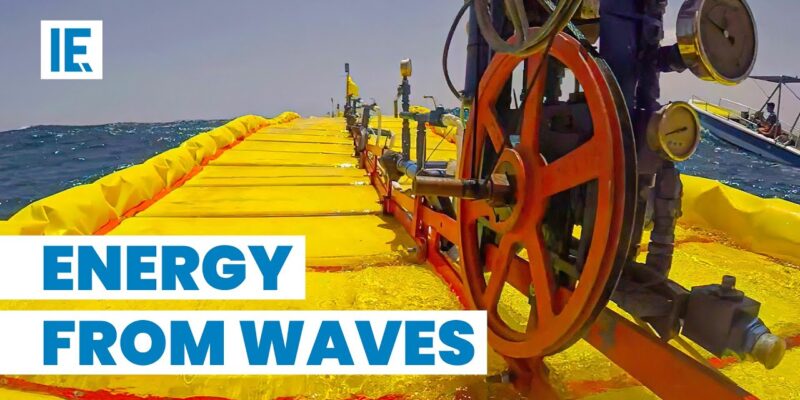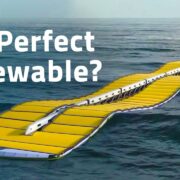
Harnessing Wave Energy: The Future of Renewable Power
Exploring the potential of wave energy as a sustainable source of power.
Renewable Energy Sources
Wind Turbines and Solar Panels: Reducing Carbon Pollution
Wind turbines and solar panels are two key players in the field of renewable energy sources. Not only do they provide clean and sustainable energy, but they also play a crucial role in reducing carbon pollution. Let’s delve deeper into how these technologies are making a significant impact on our environment.
Wind Turbines
Wind turbines harness the power of the wind to generate electricity. As the wind turns the blades of the turbine, a generator converts this mechanical energy into electrical energy. One of the biggest advantages of wind energy is that it is a clean and renewable source of power. Unlike fossil fuels, wind energy does not produce harmful greenhouse gas emissions, making it an environmentally friendly alternative.
By generating electricity from wind power, we can significantly reduce our reliance on fossil fuels, which are the primary contributors to carbon pollution. Wind turbines have the potential to replace traditional power plants that burn coal or natural gas, thereby contributing to a cleaner and greener energy grid.
Solar Panels
Solar panels harness the energy from the sun and convert it into electricity through the photovoltaic effect. The deployment of solar panels has grown significantly in recent years, thanks to advancements in technology and a push towards sustainability. Solar energy is abundant, renewable, and non-polluting, making it a compelling choice for homeowners, businesses, and utility providers.
By harnessing the power of the sun, solar panels help reduce our reliance on fossil fuels and, in turn, lower carbon emissions. The energy generated from solar panels can be used to power homes, businesses, and even entire communities, all without harming the environment.
Wave Energy: Harnessing the Power of the Ocean
While wind and solar energy are well-known renewable sources, wave energy remains a largely untapped resource with immense potential for power generation. The ocean’s waves possess a tremendous amount of kinetic energy, which can be captured and converted into electricity through various technologies.
Potential of Wave Energy
Wave energy has the advantage of being predictable and consistent, unlike solar and wind energy, which are intermittent sources. By harnessing the power of ocean waves, we can create a reliable source of renewable energy that complements other forms of clean energy.
Additionally, wave energy has a low environmental impact compared to traditional fossil fuels. It does not produce greenhouse gas emissions or contribute to air pollution, making it a sustainable and eco-friendly alternative for power generation.
Technologies for Wave Energy Conversion
There are several technologies available for converting wave energy into electricity, including point absorbers, attenuators, oscillating water columns, and overtopping devices. These technologies work by capturing the motion of the waves and converting it into mechanical or hydraulic energy, which is then used to drive a generator and produce electricity.
With ongoing research and development in the field of wave energy, we are constantly innovating new ways to harness this abundant resource and integrate it into our energy mix. As we strive towards a more sustainable future, wave energy stands out as a promising solution for clean power generation.
Renewable energy sources such as wind turbines, solar panels, and wave energy technologies are paving the way towards a more sustainable and environmentally friendly energy landscape. By harnessing the power of these clean resources, we can reduce carbon pollution, mitigate climate change, and build a greener future for generations to come.
Wave Energy Generation
Wave energy, a form of renewable energy, holds immense potential in the field of sustainable power generation. By harnessing the kinetic energy produced by the motion of waves, we can create a reliable source of electricity that is not only clean but also abundant. In this blog section, we will explore how waves can generate power akin to dams through their continuous motion and how this kinetic energy can be effectively harnessed for residential usage.
Power of Waves: Similar to Dams
Waves, a natural phenomenon driven by wind and tides, possess a significant amount of energy that can be utilized to generate power. Just like dams harness the potential energy of water by converting it into electricity through turbines, waves can also be a potent source of kinetic energy waiting to be tapped into.
Imagine the relentless motion of waves, their rhythmic rise and fall, creating a consistent energy flow that can be captured and converted into electricity. This sustainable energy source not only reduces our dependency on fossil fuels but also minimizes environmental impact, making it a compelling option for power generation.
Harnessing Kinetic Energy for Homes
One of the most exciting prospects of wave energy is its potential to be harnessed for individual homes. By utilizing wave energy converters, devices designed to capture the kinetic energy of waves and convert it into electricity, households can become more self-sufficient in terms of power generation.
These converters come in various forms, from floating buoys that bob up and down with the waves to submerged structures that harness the energy beneath the water’s surface. Regardless of the design, the principle remains the same – capturing the motion of waves and transforming it into a usable form of energy.
- Wave energy converters can be deployed near coastlines, taking advantage of the energy-rich environment where waves are most active.
- By connecting these converters to homes through power grids or storage systems, households can effectively tap into this renewable energy source.
- Wave energy, unlike solar or wind power, offers a more consistent and predictable output, making it a reliable option for residential electricity needs.
Imagine a future where homes draw power from the endless rhythm of the sea, where the ebb and flow of waves provide a sustainable and eco-friendly alternative to traditional electricity sources. With advancements in wave energy technology, this vision is gradually becoming a reality, offering a promising solution to our energy needs while preserving the planet.
As we continue to explore innovative ways to harness the power of nature, wave energy stands out as a beacon of hope for a cleaner and brighter future. By embracing this renewable energy source, we not only reduce our carbon footprint but also pave the way for a more sustainable tomorrow.
Waveline Magnet Technology
Waveline Magnet Technology is an innovative system that revolutionizes energy conversion by effectively harnessing the power of ocean waves. This cutting-edge technology not only provides a sustainable energy solution but also offers high efficiency in energy production. Let’s delve deeper into the components and working principle of this remarkable system.
Attaches to Ocean Surface for Efficient Energy Conversion
One of the key features of Waveline Magnet Technology is its ability to attach to the ocean’s surface, allowing for efficient energy conversion. By harnessing the kinetic energy present in ocean waves, this system can generate electricity without relying on traditional fuel sources. This sustainable approach not only reduces carbon emissions but also contributes to a cleaner and greener environment.
Components of Waveline Magnet Technology
The Waveline Magnet Technology system consists of several essential components that work together to harness the power of ocean waves and convert it into usable energy. Let’s explore the main components of this revolutionary technology:
- Spine: The spine of the system serves as the main support structure that keeps the components of the technology in place. It provides stability and ensures that the system remains functional even in challenging ocean conditions.
- Surface Connector: The surface connector is a crucial part of the system that attaches the technology to the ocean’s surface. This connection allows the system to efficiently capture the energy of the waves and convert it into mechanical energy.
- Levers: The levers within the system play a vital role in amplifying the mechanical energy generated by the movement of the waves. These levers help maximize the efficiency of the energy conversion process, ensuring optimal performance of the technology.
- Pump: The pump component of Waveline Magnet Technology is responsible for converting the mechanical energy generated by the system into electrical energy. This essential component completes the energy conversion process, providing a sustainable source of power.
Each component of Waveline Magnet Technology plays a crucial role in ensuring the system’s overall efficiency and effectiveness in energy conversion. By working together seamlessly, these components enable the technology to harness the power of ocean waves and produce clean and sustainable energy.
In conclusion, Waveline Magnet Technology represents a significant advancement in the field of renewable energy. By utilizing the kinetic energy of ocean waves, this innovative technology offers a sustainable and efficient solution for energy production. With its unique design and components, Waveline Magnet Technology holds great promise for a greener and more sustainable future.
Challenges and Solutions
When it comes to harnessing wave energy, there are significant challenges that must be addressed to make this technology viable and efficient. One of the primary obstacles is the corrosive nature of seawater, which can wreak havoc on traditional energy systems. However, efforts are currently underway to overcome these challenges and pave the way for a more sustainable future powered by wave energy.
Corrosive Nature of Seawater
Seawater contains high levels of salt, which can be highly corrosive to equipment and infrastructure. This presents a major challenge for wave energy technologies, as traditional materials can deteriorate quickly when exposed to constant contact with seawater. The corrosive nature of seawater not only reduces the lifespan of equipment but also increases maintenance costs and the risk of system failures.
To combat this issue, researchers and engineers are exploring alternative materials that are more resistant to corrosion. By developing coatings, alloys, and composites specifically designed to withstand the harsh marine environment, they aim to increase the durability and longevity of wave energy systems.
Efforts to Overcome Technological Challenges
Despite the challenges posed by the corrosive nature of seawater, significant progress has been made in overcoming these technological obstacles. Researchers are constantly innovating and refining wave energy technologies to make them more resilient and efficient.
One of the key solutions being pursued is the use of advanced materials such as stainless steel, titanium, and corrosion-resistant polymers in the construction of wave energy devices. These materials have shown promising results in laboratory tests and are being further developed for real-world applications.
Additionally, ongoing research is focused on designing protective coatings and corrosion inhibition techniques to shield critical components from the damaging effects of seawater. By implementing robust maintenance strategies and regular inspections, operators can identify and address corrosion issues before they escalate and cause system failures.
TL;DR
Wave energy faces challenges due to the corrosive nature of seawater, but researchers are developing advanced materials and protective coatings to overcome these obstacles and make wave energy a viable and sustainable source of power.













